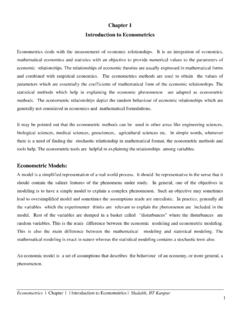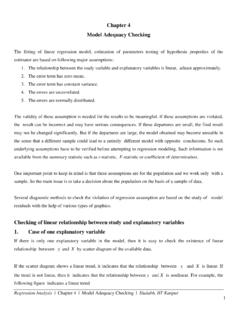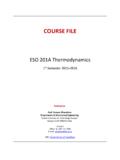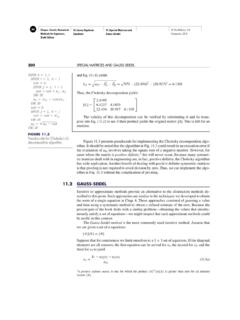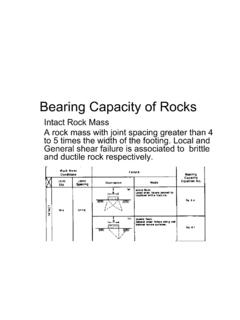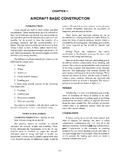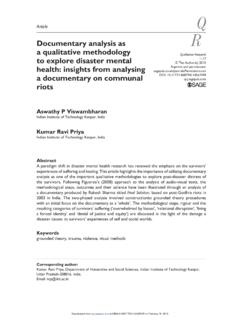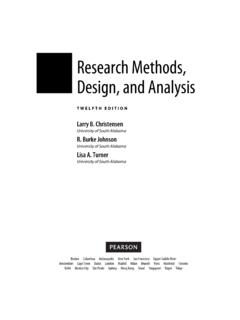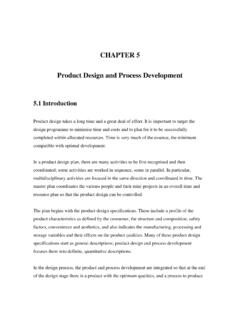Transcription of Chapter 8 Factorial Experiments - IIT Kanpur
1 Analysis of Variance | Chapter 8 | Factorial Experiments | Shalabh, IIT Kanpur 1 1 Chapter 8 Factorial Experiments Factorial Experiments involve simultaneously more than one factor each at two or more levels. Several factors affect simultaneously the characteristic under study in Factorial Experiments and the experimenter is interested in the main effects and the interaction effects among different factors. First we consider an example to understand the utility of Factorial Experiments . Example: Suppose the yield from different plots in an agricultural experiment depend upon 1. (i) variety of crop and (ii) type of fertilizer. Both the factors are in the control of experimenter. 2. (iii) Soil fertility. This factor is not in the control of experimenter. In order to compare different crop varieties - assign it to different plots keeping other factors like irrigation, fertilizer, etc.
2 Fixed and the same for all the plots. - The conclusions for this will be valid only for the crops grown under similar conditions with respect to the factors like fertilizer, irrigation etc. In order to compare different fertilizers (or different dosage of fertilizers) - sow single crop on all the plots and vary the quantity of fertilizer from plot to plot. - The conclusions will become invalid if different varieties of crop are sown. - It is quite possible that one variety may respond differently than another to a particular type of fertilizer. Suppose we wish to compare - two crop varieties a and b, keeping the fertilizer fixed and - three varities of fertilizers A,B and C. This can be accomplished with two randomized block designs (RBD) by assigning the treatments at random to three plots in any block and two crop varieties at random.
3 Analysis of Variance | Chapter 8 | Factorial Experiments | Shalabh, IIT Kanpur 2 2 The possible arrangement of the treatments may appear can be as follows. With these two RBDs, - the difference among two fertilizers can be estimated - but the difference among the crop varieties cannot be estimated. The difference among the crop varieties is entangled with the difference in blocks. On the other hand, if we use three sets of three blocks each and each block having two plots, then - randomize the varieties inside each block and - assign treatments at random to three sets. The possible arrangement of treatment combinations in blocks can be as follows: Here the difference between crop varieties is estimable but the difference between fertilizer treatment is not estimable.
4 Factorial Experiments overcome this difficulty and combine each crop with each fertilizer treatment. There are six treatment combinations as aA, aB, aC, bA, bB, bC. Keeping the total number of observations to be 18 (as earlier), we can use RBD with three blocks with six plots each, Now we can estimate the - difference between crop varieties and - difference between fertilizer Experiments involves simultaneously more than one factor each at two or more levels. bB bA bC bC bB bA bA bC bB and bB aB aB bB bB aB and bA aC aB bB aA bC aA aC bC aB bB bA bB aB bA aC aA bC aA aB aC aC aA aB aB aC aA aC bC bC aC aC bC aA bA bA aA bA aA , Analysis of Variance | Chapter 8 | Factorial Experiments | Shalabh, IIT Kanpur 3 3 If the number of levels for each factor is the same, we call it is symmetrical Factorial experiment .
5 If the number of levels of each factor is not same, then we call it as a symmetrical or mixed Factorial experiment . We consider only symmetrical Factorial Experiments . Through the Factorial Experiments , we can study the - individual effect of each factor and - interaction effect. Now we consider a 22 Factorial experiment with an example and try to develop and understand the theory and notations through this example. A general notation for representing the factors is to use capital letters, , A,B,C etc. and levels of a factor are represented in small letters. For example, if there are two levels of A, they are denoted as 0a and 1a. Similarly the two levels of B are represented as 0b and 1b. Other alternative representation to indicate the two levels of A is 0 (for 0a) and 1 (for 1a). The factors of B are then 0 (for 0b) and 1 (for 1b).
6 Note: An important point to remember is that the Factorial experiment conducted in a design of experiment . For example, the Factorial experiment is conducted as an RBD. Factorial Experiments with factors at two levels (22 Factorial experiment ): Suppose in an experiment , the values of current and voltage in an experiment affect the rotation per minutes ()rpm of a fan speed. Suppose there are two levels of current. - 5 Ampere, call it as level 1 1()C and denote it as 0a - 10 Ampere, call it as level 2 1()C and denote it as 1a. Similarly, the two levels of voltage are - 200 volts, call it as level 1 0()V and denote it as 0b - 220 volts, call it as level 2 1()V and denote it as 1b. The two factors are denoted as ,A say for current and ,B say for voltage. Analysis of Variance | Chapter 8 | Factorial Experiments | Shalabh, IIT Kanpur 4 4 In order to make an experiment , there are 4 different combinations of values of current and voltage.
7 1. Current = 5 Ampere and Voltage = 200 Volts, denoted as 0 000 CVab 2. Current = 5 Ampere and Voltage = 220 Volts, denoted as 0 101 CVab . 3. Current = 10 Ampere and Voltage = 200 Volts, denoted as 1 010 CVab 4. Current = 10 Ampere and Voltage = 220 Volts, denoted as 1 111 CVab The responses from those treatment combinations are represented by 0 001(1), () ( ),ababb 10() ()aba and 11( )()a bab , respectively. Now consider the following: I. 1()( )2oooCVCV+: Average effect of voltage for current level 0C : 1( )( )(1) ( )22oooababb++ ( )( ):2oCVCV+Average effect of voltage for current level C1 :111( )( )() ( )22oababaab++ Compare these two group means (or totals) as follows: Average effect of 1V level Average effect at 0V level ()( ) (1)()22 Main effect of voltage= Main effect of .babaB++= = Comparison like (CoV1) - (CoVo) (a) - (1): indicate the effect of voltage at current level Co and (C1V1) - (C1V0) (ab) - (b): indicate the effect of voltage at current level C1.
8 Analysis of Variance | Chapter 8 | Factorial Experiments | Shalabh, IIT Kanpur 5 5 The average interaction effect of voltage and current can be obtained as 11111 Average effect of voltageAverage effect of voltageat current levelat current level Average effect of voltage at different levels of current.( )( ) ( )()22( )() ()(1)22 AoooooIICVCVC VC Vabba = = = =verage interaction effect. Similarly 101111()( )(1) ( ):Average effect of current at voltage level .22( )( )() ( ): Average effect of current at voltage level 22ooooC VCVbVC VCVaabV++=++= Comparison of these two as 010 1110 01 0 Average effect of currentAverage effect of currentat voltage levelat voltage level( )( ) ( )( )22()( ) (1)()22 Main effect of current= Main effect VCVC VCVaabbA ++= ++= = Comparison like 100 00110 11() ()( ) (1) : Effect of current at voltage level () ()() ( ) : Effect of current at voltage level CVC VbVC VC VabaV = = : The average interact effect of current and voltage can be obtained as 01110 11 00 0 Average effect of currentAverage effect of currentat voltage levelat voltage levelAverage effect of current at different levels of voltage( )( ) ( )()22( )() ()(1)22 AveVVCVC VCVC Vabab = = = =rage interaction effect Same as average effects of voltage at different levels of current.
9 (It is expectedthe interaction effect of current and voltage is same as the interaction effect of voltage and cuthat=rrent). Analysis of Variance | Chapter 8 | Factorial Experiments | Shalabh, IIT Kanpur 6 6 The quantity 0 01 00 111( )( )( )( )(1)()()( )44C VCVC VCVabab++++++= gives the general mean effect of all the treatment combination. Treating ()ab as ( )( )ab symbolically (mathematically and conceptually, it is incorrect), we can now express all the main effects, interaction effect and general mean effect as follows: [][][]( ) ()(1) ( )1(1)(1)Main effect of () ( ) ( ) (1)2222( ) ()(1) ( )1(1)(1)Main effect of () ( ) ( ) (1)2222( )() ()(1) 1 Interaction effect of and () ( ) (1) ( )222aabbabAabbababaabBabababbaABabab++ += = + =+++ = = + = = = + =[](1)(1)2(1) ( ) ( ) ()1(1)(1)General mean effect ()(1) ( ) ( ) ()444ababababMabab ++++ +== +++ = Notice the roles of + and signs as well as the divisor.
10 There are two effects related to A and B. To obtain the effect of a factor, write the corresponding factor with sign and others with + sign. For example, in the main effect of A, a occurs with sign as in (a - 1) and b occurs with + sign as in (b + 1). In AB, both the effects are present so a and b both occur with + signs as in (a + 1)(b + 1). Also note that the main and interaction effects are obtained by considering the typical differences of averages, so they have divisor 2 whereas general mean effect is based on all the treatment combinations and so it has divisor 4. There is a well defined statistical theory behind this logic but this logic helps in writing the final treatment combination easily. This is demonstrated later with appropriate reasoning. Other popular notations of treatment combinations are as follows: bab Sometimes 0 is referred to as low level and 1 is referred to high level.
